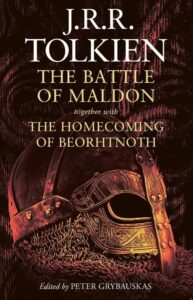
Tolkien translated a 325-line fragment of an epic poem
In 991, Vikings attacked Anglo-Saxons in eastern Essex, not far from the current city of Chelmsford, northeast of London. The River Blackwater, connected by a bridge, separated the two forces. The Anglo-Saxons likely could have held off the Vikings for a considerable period. But the Vikings asked permission to cross the bridge to fight, and it was granted by the Anglo-Saxon leader Beorhtnoth. It’s not known why, except perhaps that Beorhtnoth thought he might find glory in battle.
And that he did, except it wasn’t what he expected. The hand-to-hand combat was vicious and intense. When the Battle of Maldon ended, Beorhtnoth was dead, along with several members of his family, and the Vikings were victorious.
What detail we have of the battle is contained in the fragment of an epic poem probably written shortly after the battle. It’s one of the oldest British historical manuscripts, older even than Beowulf. J.R.R. Tolkien spent considerable time, particularly in the earlier part of his academic career, studying and translating the poem and researching the period. He also wrote a verse play himself, a fictional attempt to file in some of the missing texts.

It’s an informative and fascinating work. And it’s more than that — it shows how poetry, especially epic poetry, was significant in the development of Old English.
Grybauskas divides the work into three parts. First, he presents Tolkien’s epic poem written as a verse play entitled “The Homecoming of Beorhtnoth Beorhthelm’s Son.” The play has two characters, and older man and a younger one, sent by the Bishop of Ely to retrieve Beorthnoth’s body from the mounds of the dead on the battlefield. The Anglo-Saxon had been a patron of Ely, and the bishop desired to bury him in the church there.
Following is Tolkien’s translation of the fragment “The Battle of Maldon,” with an introductory note and extensive notes. Finally, the book includes a lecture by Tolkien on the tradition of versification in Old English. Grybauskas also includes 30 pages of appendices and a bibliography.

Peter Grybauskas
Grybauskas avoids academic jargon. This is an eminently readable work, aimed at a general audience — people unfamiliar with both Anglo-Saxon and Viking history as well as Tolkien’s more scholarly work. This is Tolkien the professor and Old English translator, not the storyteller who would change fantasy literature forever. And yet the reader can see where the work of the scholar couldn’t help but inform the work of the storyteller.
In addition to teaching, Grybauskas is a scholar himself on the subject on Tolkien and his work and literature. In 2021, he published A Sense of Tales Untold: Exploring the Edges of Tolkien’s Literary Canvas. He’s also written a number of essays for literary and academic journals.
J.R.R. Tolkien: The Battle of Maldon offers insights into Tolkien, his scholarly work, the historical period of the late 10th century, and the role that epic poetry played in recording and commemorating battles in the Anglo-Saxon world. We also get a small glimpse into some of the knowledge inside Tolkien’s head that would emerge in some of his great fictional battle scenes.
Related:
An interview with Peter Grybauskas on A Sense of Tales Untold
Photo by Sonja und Jens, Creative Commons, via Flickr. Post by Glynn Young.
How to Read a Poem uses images like the mouse, the hive, the switch (from the Billy Collins poem)—to guide readers into new ways of understanding poems. Anthology included.
“I require all our incoming poetry students—in the MFA I direct—to buy and read this book.”
—Jeanetta Calhoun Mish
- Poets and Poems: Donna Vorreyer and “Unrivered” - October 7, 2025
- Poet Sidney Lanier and the Lost Cause - October 2, 2025
- Poets and Poems: A.J. Thibault and “We Lack a Word” - September 30, 2025


Bethany says
“We also get a small glimpse into some of the knowledge inside Tolkien’s head that would emerge in some of his great fictional battle scenes.”
How cool, Glynn, thanks for this. Is there a certain battle in Middle Earth that comes to mind in this connection? I’m rereading (listening to the audiobook of) The Fellowship of the Ring right now, but I’m thinking ahead to maybe Helm’s Deep or Pelennor Fields? Always enjoy learning more about Tolkein’s world-making. 🙂
Bethany says
*Are there certain battles …
(I wish I could edit comments!)
Glynn says
Pick one where the defenders make a colossal miscalculation. Like Helm’s Deep. Or Saruman defending Isengard from the Ents.
Bethany says
I see, yes. Oh, those dear Ents!
“I am not altogether on anybody’s side, because nobody is altogether on my side, if you understand me: nobody cares for the woods as I care for them, not even Elves nowadays.”
—Treebeard, The Two Towers